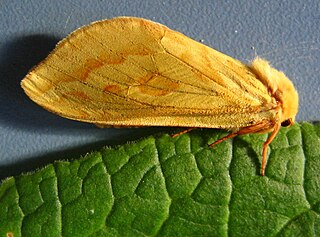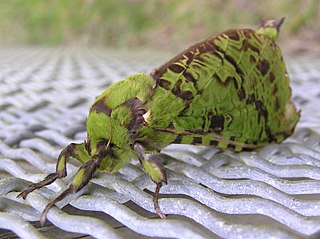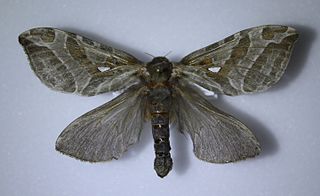
The Hepialidae are a family of insects in the lepidopteran order. Moths of this family are often referred to as swift moths or ghost moths.

The ghost moth or ghost swift is a moth of the family Hepialidae. It is common throughout Europe, except for in the far south-east.

Aenetus is a genus of moths of the family Hepialidae. There are 24 described species found in Indonesia, New Guinea, New Caledonia, Australia and New Zealand. Most species have green or blue forewings and reddish hindwings, but some are predominantly brown or white. The larvae feed in the trunks of living trees, burrowing horizontally into the trunk, then vertically down.
The Hepialoidea are the superfamily of "ghost moths" and "swift moths".

The gold swift is a moth belonging to the family Hepialidae. Until recently it was placed in the genus Hepialus. The species was first described by Carl Linnaeus in his 1758 10th edition of Systema Naturae. It is a widespread species of Europe, its distribution following that of its food plant, bracken.

Abantiades latipennis, known as the Pindi moth, is a species of moth in the family Hepialidae. It may also be referred to as a swift moth or a ghost moth, as this is a common name associated with Hepialidae. Endemic to Australia and identified in 1932, it is most populous in temperate rainforest where eucalypti are prevalent, as the larvae feed primarily on the roots of these trees. Females lay eggs during flight in a scattering fashion. The larvae live for over eighteen months underground, while adult moths survive for approximately one week, as they have no mouthparts with which to feed. The moths are preyed upon by a number of predators, including bats and owls. Brown in colour overall, males are paler and the identifying silver bars of the male's wings are more prominent than those of the female's, with dark margins. Male adults are generally smaller.
Aplatissa michaelis is a species of moth of the family Hepialidae. It is endemic to Brazil.
Aplatissa strangoides is a species of moth of the family Hepialidae. It is endemic to Brazil.
Bipectilus gracilirami is a species of moth of the family Hepialidae. It is known from Nepal.
Bipectilus latirami is a species of moth of the family Hepialidae. It is known from Nepal.
Bipectilus paraunimacula is a species of moth of the family Hepialidae. It is known from China (Hunan).
Bipectilus perfuscus is a species of moth of the family Hepialidae. It is known from China (Xizang).
Bipectilus unimacula is a species of moth of the family Hepialidae. It is known from China (Kiangsu).
Bipectilus yunnanensis is a species of moth of the family Hepialidae. It is known from China (Yunnan).
Calada fuegensis is a species of moth of the family Hepialidae. It is endemic to Argentina.
Calada migueli is a species of moth of the family Hepialidae. It is endemic to Argentina.

Sthenopis argenteomaculatus, the silver-spotted ghost moth, is a species of moth of the family Hepialidae. It was described by Thaddeus William Harris in 1841, and is known in North America from Nova Scotia to Virginia and west to Minnesota.

Sthenopis pretiosus, the gold-spotted ghost moth, is a species of moth of the family Hepialidae. It was first described by Gottlieb August Wilhelm Herrich-Schäffer in 1856. It can be found in found Brazil, Venezuela and in the north-eastern United States and south-eastern Canada.






